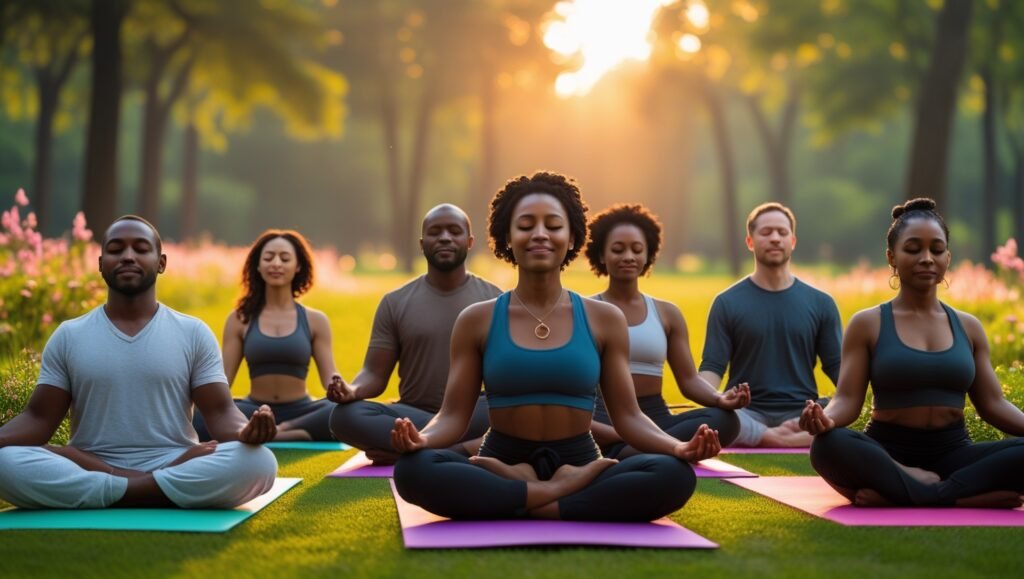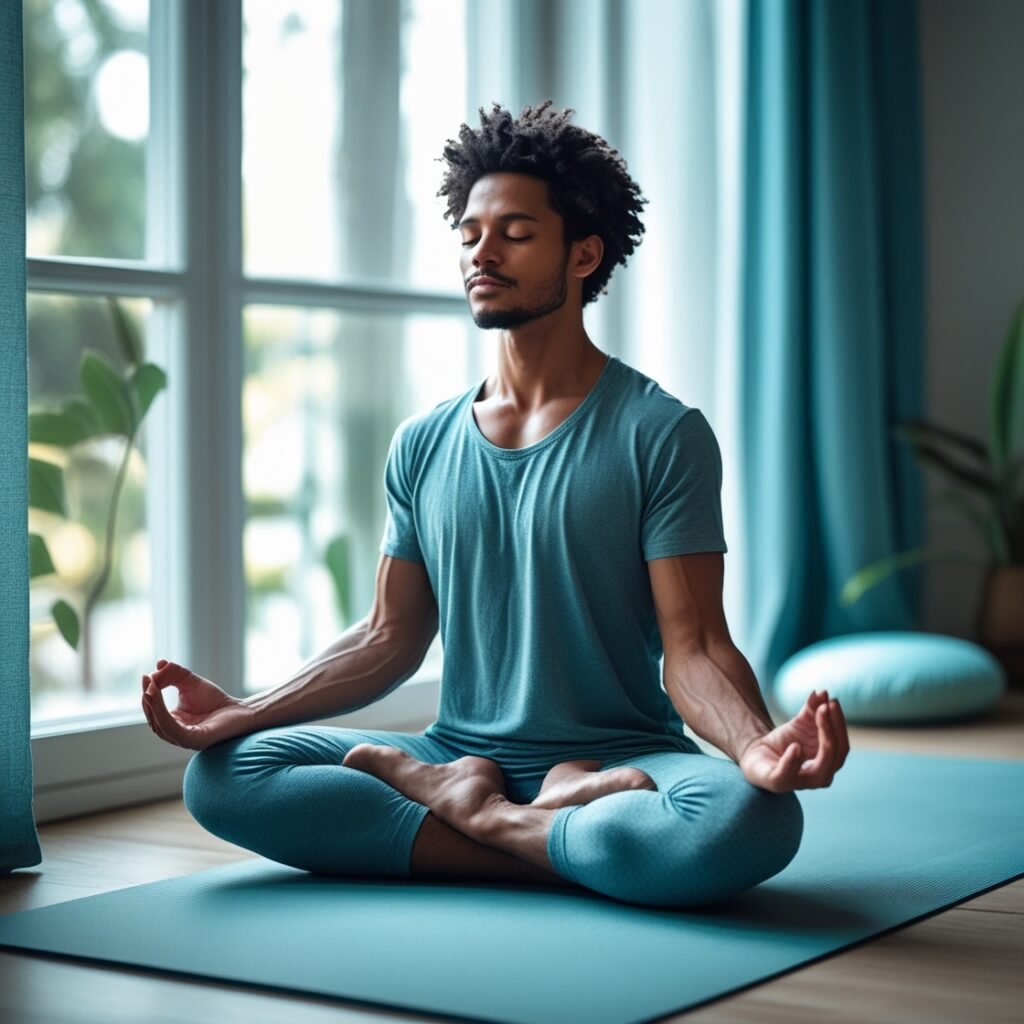Table of Contents
Introduction
Have you ever felt overwhelmed by stress, distractions, or the constant buzz of daily life? You’re not alone. In today’s fast-paced world, finding moments of calm can feel impossible—but what if there was a simple, science-backed way to quiet your mind and recharge?
That’s where meditation comes in.
Meditation isn’t just for monks or spiritual gurus—it’s a powerful tool for anyone seeking mental clarity, emotional balance, and even physical health benefits. Whether you’re a busy professional, a student, or someone just looking for a way to unwind, it can help you:
- Reduce stress and anxiety – Studies show that just 10 minutes a day can lower cortisol levels.
- Improve focus and productivity – Train your brain to stay present, even in chaos.
- Enhance emotional well-being – Cultivate patience, self-awareness, and resilience.
But What Exactly Is it?
At its core, meditation is the practice of training your attention. It’s not about emptying your mind (that’s nearly impossible!) but rather observing your thoughts without judgment. Think of it like exercise for your brain—strengthening focus, reducing mental clutter, and fostering inner peace.
Why Start Meditating Today?
You might think, “I don’t have time,” or “I’m not good at sitting still.” The truth? Meditation is more accessible than you think. You don’t need special equipment, hours of free time, or a perfectly quiet space. Even a few minutes can make a difference.
Ready to give it a try? Let’s dive deeper—so you can start experiencing its benefits sooner than you think.

The Benefits of Meditation: How It Transforms Your Mind and Body
What if just 10 minutes a day could rewire your brain, melt away stress, and even boost your immune system? That’s not a wellness trend—it’s the proven power of meditation.
Backed by neuroscience and centuries of practice, meditation isn’t just about “feeling relaxed.” It’s a game-changer for your mental, emotional, and physical health. Here’s how:
1. Mental Clarity & Stress Relief
Ever notice how your mind races with worries, to-do lists, or regrets? Meditation acts like a reset button:
- Reduces cortisol (the stress hormone) by up to 30%, according to Harvard research.
- Improves focus by thickening the prefrontal cortex—the brain’s “command center” for decision-making.
- Helps break anxiety cycles by teaching you to observe thoughts without reacting.
Do you want to know more about how to use meditation for anxiety relief?
2. Physical Health Perks You Didn’t Expect
Meditation isn’t just mental—it impacts your body in surprising ways:
✅ Lowers Blood Pressure
Studies show mindfulness meditation can be as effective as some medications for hypertension.
✅ Boosts Immunity
Regular practice increases antibodies (your body’s defense cells) and reduces inflammation.
✅ Improves Sleep
By calming the nervous system, meditation helps you fall asleep faster and stay asleep longer.
3. Emotional Resilience & Happiness
Imagine handling life’s ups and downs with calm instead of chaos. Meditation helps by:
- Increasing self-awareness (so you don’t spiral into negative thought loops).
- Releasing “feel-good” hormones like serotonin and endorphins.
- Strengthening empathy—research shows meditators have more gray matter in brain regions tied to compassion.
The Best Part? It’s Free & Fits Any Lifestyle
No apps, gear, or perfect conditions needed. Whether you’re a busy parent, CEO, or student, the benefits are yours for the taking.
Ready to experience them? The next section breaks down simple ways to start—no experience required.
Different Types of Meditation: Find Your Perfect Practice
Think all meditation is the same? Think again! Just like exercise, there are many styles—and the best one depends on your personality, goals, and lifestyle.
Whether you’re a busy professional needing quick stress relief or someone seeking deeper self-awareness, there’s a practice designed for you. Let’s explore the most popular (and practical) types:
1. Mindfulness Meditation: The Art of Being Present
Best for: Reducing anxiety, improving focus, and staying grounded
- What it is: Focusing on the present moment—your breath, bodily sensations, or surroundings—without judgment.
- Why it works: Trains your brain to break free from rumination (that exhausting loop of “what ifs” and regrets).
- Try it now: Close your eyes and notice 3 sounds around you. That’s mindfulness in action!
“Mindfulness helped me stop catastrophizing small work problems. Now I handle stress way better.” — Mark, IT manager
2. Guided vs. Silent Meditation: Which Suits You?
Guided Meditation
- Ideal for beginners (uses an app or teacher’s voice for direction).
- Great for: Sleep, visualization, or specific goals like confidence-building.
- Popular formats: Body scans, loving-kindness meditations, or stress relief sessions.
Silent Meditation
- Perfect for self-directed practitioners who prefer solitude.
- Common types: Breath awareness, mantra repetition, or open monitoring.
- Pro tip: Start with short sessions (5 minutes) and increase gradually.
3. Movement-Based Meditation: For Those Who Can’t Sit Still
If the idea of sitting quietly makes you fidget, try these active alternatives:
✅ Walking Meditation
- Focus on each step and your body’s movement.
- Ideal for nature lovers or office workers needing a mindful break.

✅ Yoga & Tai Chi
- Combines breathwork with gentle movement.
- Enhances flexibility while calming the mind.
4. Specialized Techniques for Specific Goals
| Goal | Type | Why It Works |
|---|---|---|
| Deep Relaxation | Body Scan Meditation | Releases physical tension systematically |
| Self-Compassion | Loving-Kindness (Metta) | Cultivates empathy for yourself & others |
| Spiritual Growth | Transcendental Meditation | Uses mantras to access deeper awareness |
How to Choose Your Practice
Ask yourself:
- Do I prefer structure (guided) or independence (silent)?
- Am I seeking stress relief, emotional healing, or spiritual connection?
- Does movement help me focus better?
Remember: There’s no “right” way—only what works for you. Experiment and notice how each type makes you feel.
Up next: Simple steps to build your meditation habit—even if you’ve failed before!
How to Start Meditating: A No-Stress Guide for Beginners
So you’re ready to meditate—but where do you actually begin? If the thought of “clearing your mind” feels impossible (hello, mental grocery lists!), don’t worry. Starting to meditate is easier than you think. Here’s your stress-free roadmap:
Step 1: Ditch the Myths (You Don’t Need to Be Perfect)
Let’s bust three big misconceptions right now:
❌ Myth: “I must stop all thoughts.” → Truth: Your brain’s job is to think. Just notice thoughts like passing clouds.
❌ Myth: “I need 30 minutes daily.” → Truth: Even 3-5 minutes counts. Progress > perfection.
❌ Myth: “I must sit cross-legged.” → Truth: Meditate in a chair, lying down, or even washing dishes.
Step 2: The 5-Minute Starter Routine
Set the Scene (1 min):
- Find a quiet-ish spot (a parked car or bathroom works in a pinch!).
- Sit comfortably—no need to contort. Pro tip: Place a pillow under your hips if on the floor.
Focus on Your Breath (3 min):
- Close your eyes and notice:
- The cool air entering your nostrils
- Your belly rising/falling
- When your mind wanders (it will!), gently return to your breath—no self-scolding.
Gently Wrap Up (1 min):
- Wiggle fingers/toes → slowly open eyes.
- Smile! You just meditated.
Step 3: Hack Your Habit
Make it stick with these science-backed tips:
🔹 Pair it with a daily anchor
- Example: Meditate after brushing your teeth or before your first coffee sip.
🔹 Use tech wisely
- Try apps like Headspace (guided) or Insight Timer (free timers).
- Set a gentle alarm—no jarring buzzers!
🔹 Track small wins
- Mark a calendar each day you meditate. After 7 days, celebrate!
Common Beginner Hurdles (And Fixes)
| Challenge | Solution |
|---|---|
| “I keep falling asleep!” | Try seated meditation (not lying down) or meditate earlier in the day |
| “My back hurts.” | Use wall support or a cushion |
| “I don’t feel anything.” | That’s normal! Benefits compound over time |
When Will I “Get Good”?
Meditation isn’t like learning guitar—there’s no “bad” or “good.” Some days your mind will feel calm; other days it’ll race. Both are perfect.
Progression looks like:
Week 1: Noticing when you’re distracted
Month 1: Catching stress reactions faster
Year 1: Feeling fundamentally different in daily life
Remember: Every meditator was once a beginner. Your 5 minutes today are planting seeds for a calmer tomorrow.
Next up: Troubleshooting tips for when motivation dips (because it happens to everyone).
Meditation Challenges: Real Struggles & How to Beat Them
Let’s be honest—it isn’t always candles and calm. Some days, your brain feels like a browser with 100 tabs open. That’s normal! Here’s how to navigate the most common hurdles (with practical fixes that actually work).
1. “I Can’t Stop Thinking!”
The truth: This isn’t a problem—it’s part of the process.
✅ Try this instead:
- Label thoughts: Silently note “thinking” when your mind wanders, then return to your breath.
- Use anchors: Focus on physical sensations (like your hands resting on your knees) when mental chatter overwhelms.
- Remember: Noticing distractions means you’re meditating correctly. The magic is in the returning, not the empty mind.
2. “I Fall Asleep Every Time”
Why it happens: Your body finally gets permission to rest!
✅ Stay awake with these tweaks:
- Change your position: Sit upright (even against a wall) instead of lying down.
- Meditate earlier: Try morning sessions before your energy dips.
- Open your eyes: Softly gaze at a spot on the floor if needed.
3. “I Don’t Have Time”
The hack: Micro-meditations count.
✅ Sneak in mindfulness:
| Scenario | 10-Second Meditation |
|---|---|
| Waiting for coffee | Feel the cup’s warmth in your hands |
| At a stoplight | Take three deep breaths |
| Email overwhelm | Notice your feet on the floor for 5 breaths |
4. “It Feels Boring/Pointless”
Reframe it: Meditation is like brushing teeth for your mind—you don’t wait to “feel like it.”
✅ Spark motivation:
- Track subtle wins: Less road rage? Fewer late-night worry spirals? That’s progress.
- Mix it up: Try walking meditations or mantra repetition if seated silence feels stale.
- Connect to goals: Remind yourself why you started (better sleep? less anxiety?).
5. “I Keep Quitting”
The solution: Make it idiot-proof.
✅ Build consistency:
🔹 Start comically small: 1 minute daily for a week.
🔹 Pair with habits: Meditate right after your shower or while waiting for your computer to boot.
🔹 Forgive slip-ups: Missed a day? Just restart. Meditation is a practice, not a performance.
When to Seek Alternatives
If meditation consistently triggers anxiety or trauma:
- Try guided body scans (more grounding)
- Switch to movement practices (yoga, qi gong)
- Consult a therapist specializing in mindfulness
Remember: Every meditator faces these challenges. What matters isn’t perfection—it’s showing up again tomorrow.

Conclusion: Your Journey to Mindfulness Starts Now
You’ve just explored the transformative power of meditation—from its science-backed benefits to practical ways to overcome common hurdles. But here’s the most important thing to remember:
It isn’t about achieving perfection—it’s about showing up for yourself, one breath at a time.
Key Takeaways to Carry Forward
- Even 3-5 minutes daily can rewire your brain for less stress and more clarity
- Every meditator struggles with distractions—the magic is in gently returning to your focus point
- There’s no “right way” to meditate—only what works for YOU
Your Next Steps
1️⃣ Start small: Try the 5-minute beginner routine from earlier today
2️⃣ Be patient: Notice subtle changes (better sleep? more patience?) before expecting big shifts
3️⃣ Stay curious: Revisit different meditation types as your needs evolve
“The best time to plant a tree was 20 years ago. The second best time is now.” — This applies perfectly to your meditation practice.
We’d Love to Hear From You
- Which type resonated most with you?
- What challenges are you facing? (Comment below—we’ll help troubleshoot!)
Want more guidance? Download our free [Beginner’s Meditation Checklist] to:
✓ Set up your ideal meditation space
✓ Track your 7-day starter challenge
✓ Access bonus audio guides
Remember: Every moment is a new chance to begin again. Your path to greater peace starts with a single breath.
References
- Harvard Medical School (2018). “Mindfulness Meditation May Ease Anxiety, Mental Stress”. Harvard Health Publishing.
https://www.health.harvard.edu - Goyal, M., et al. (2014). “Meditation Programs for Psychological Stress and Well-being”. JAMA Internal Medicine.
https://jamanetwork.com/journals/jamainternalmedicine - National Center for Complementary and Integrative Health (NCCIH) (2021). “Meditation: In Depth”. U.S. Department of Health.
https://www.nccih.nih.gov/health/meditation-in-depth - Tang, Y.Y., et al. (2015). “The Neuroscience of Mindfulness Meditation”. Nature Reviews Neuroscience.
https://www.nature.com/articles/nrn3916 - Headspace Research (2020). “The Science of Meditation”.
https://www.headspace.com/science - Kabat-Zinn, J. (1990). “Full Catastrophe Living: Using the Wisdom of Your Body and Mind to Face Stress, Pain, and Illness”. Delta.
- American Psychological Association (APA) (2019). “What Are the Benefits of Mindfulness?”
https://www.apa.org/topics/mindfulness/benefits




